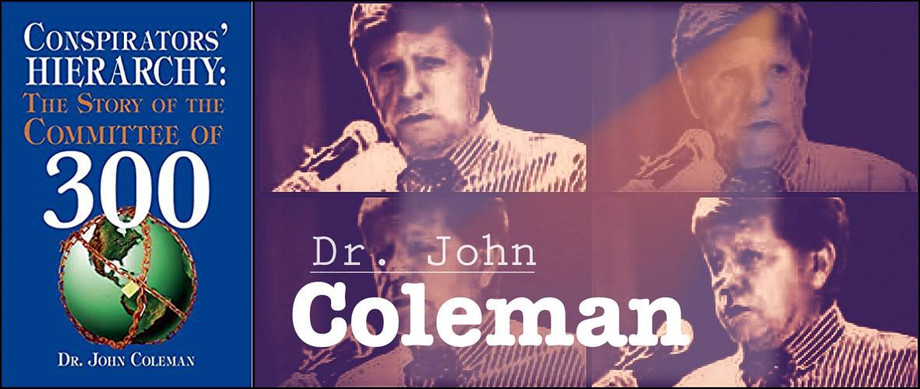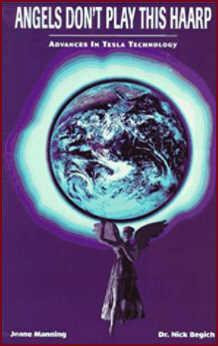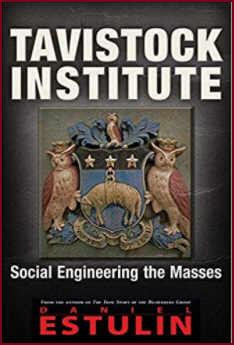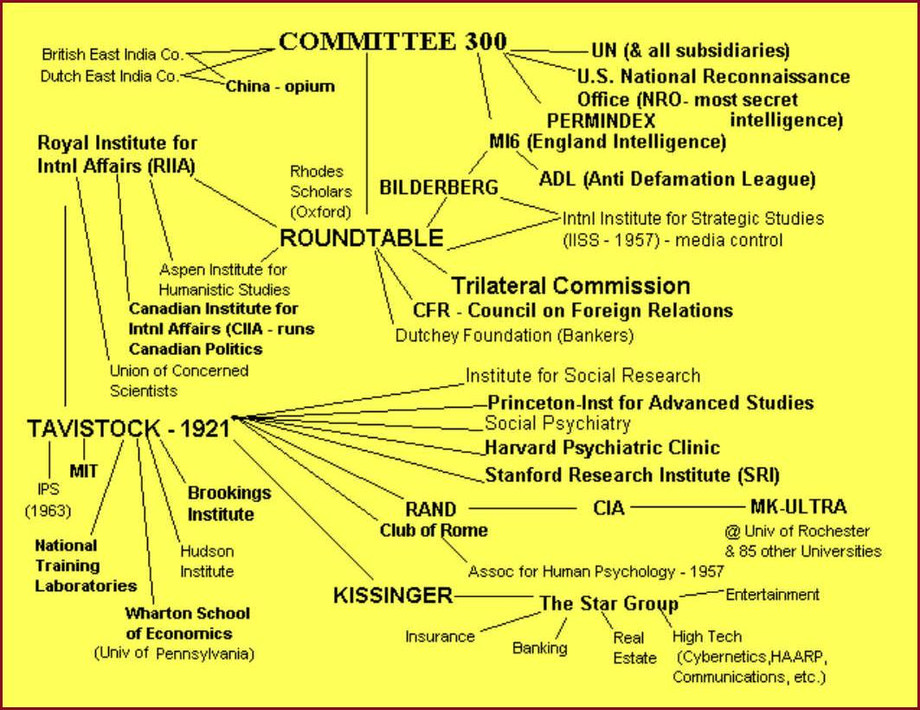FROM THE CIA LIBRARY

__________________________________________________________________________________________
CONSPIRATORS' HIERARCHY: THE STORY OF THE COMMITTEE OF 300 by Dr. John Coleman
Page 12: "The Committee of 300 looks to social convulsions on a global scale, followed by depressions, as a softening-up technique for bigger things to come, as its principal method of creating masses of people all over the world who will become its "welfare" recipients of the future. The committee appears to base much of its important decisions affecting mankind on the philosophy of Polish aristocrat, Felix Dzerzinski, who regarded mankind as being slightly above the level of cattle. As a close friend of British intelligence agent Sydney Reilly (Reilly was actually Dzerzinski's controller during the Bolshevik Revolution's formative years), he often con- fided in Reilly during his drinking bouts. Dzerzinski was, of course, the beast who ran the Red Terror apparatus. He once told Reilly, while the two were on a drinking binge, that "Man is of no importance. Look at what happens when you starve him. He begins to eat his dead companions to stay alive. Man is only interested in his own survival. That is all that counts. All the Spinoza stuff is a lot of rubbish."
- THE GLOBAL 2000 REPORT TO THE PRESIDENT - ENTERING THE TWENTY-FIRST CENTURY
Gus Speth, The Global 2000 Report to the President, 8 B.C. Envtl. Aff. L. Rev. 695 (1980) - Global 2000 Study Statement on the Report to the President. (July 24,1980)
Response to the Global 2000 report by Pres., Jimmy Carter - Klaus Schwab, Covid-19, Tavistock Inst., Great Reset & 4th Reich
- The Crown, Tavistock Institute and Control of Facebook
This graphic is found on the last page of the PDF version available on the CIA website . Of special interest is (1) "HAARP" listed under "The Star Group" (High Tech) in the bottom rh corner. (2) British Tavistock Institute Propaganda and Media mind-control has long been inserted into American Universities.
This is an eyeball overview of how a committee of 300 can exercise control over multiple industries, science and technology, universities, US military and mainstream mockingbird news agencies to inflict mass public hypnosis over events like the Kennedy Assassination, the staged Apollo Mission, 9/11 False Flag, staged mass shootings and now the COVID-19 plandemic.
_______________________________________________________________________________________________
(1) HAARP - The "High Frequency Active Auroral Research Program" technology is covered under US Patent 4,686,605 on the “Method and Apparatus for Altering a Region in the Earth’s Atmosphere, Ionosphere, and/or Magnetosphere.”
 "Angels Don't Play This HAARP: Advances in Tesla Technology"
"Angels Don't Play This HAARP: Advances in Tesla Technology"
________________________________________________________________________________________________
HAARP is an advanced Tesla technology capable of creating changes in the weather to make the atmosphere warmer or cooler. In recent decades a network of facilities modeled after the original HAARP facility in Gakona, AK are now in operation. High frequency radio waves focused into high regions of upper atmosphere can alter jet streams and control major high and low pressure weather systems. Coordination of these stations can heat the atmosphere to be conveniently blamed on carbon dioxide to promote the Global Warming deception.
Despite it's amazing capability to control the weather, HAARP technology seems to have never been deployed to weaken, re-direct or stop Hurricane formation. Despite a technology capable of doing good for humanity, we seem to be witnessing more intense warming, stronger hurricanes and more destructive tornadoes.
"Angels Don't Play This HAARP: Advances in Tesla Technology" is a book written by Nick Begich in 1995. Begich is the eldest son of the late United States Congressman from Alaska, Nick Begich Sr., and political activist Pegge Begich. He is well known in Alaska for his own political activities. He was twice elected President of both the Alaska Federation of Teachers and the Anchorage Council of Education. He has been pursuing independent research in the sciences and politics for most of his adult life. Begich received Doctor of Medicine (Medicina Alternitiva), honoris causa, for independent work in health and political science, from The Open International University for Complementary Medicines, Colombo, Sri Lanka, in November 1994.
The inside glap of his book reads: "This is a book about non-lethal weapons, mind control, weather warfare and the government's plan to control the environment, or maybe even destroy it in the name of national defense."
VIDEO - HAARP - Angels Still Don't Play This Harp - Nick Begich
_______________________________________________________________________________________
 "Tavistock Institute: Social Engineering the Masses" by Daniel Estulin, PhD (2015)
"Tavistock Institute: Social Engineering the Masses" by Daniel Estulin, PhD (2015)
(2) The Tavistock Institute, in Sussex, England, was founded in it's current form in 1947. It describes itself as a nonprofit charity that applies social science to contemporary issues and problems. But this book posits that it is the world’s center for mass brainwashing and social engineering activities. It grew from a somewhat crude beginning at Wellington House into a sophisticated organization that was to shape the destiny of the entire planet, and in the process, change the paradigm of modern society. In this eye-opening work, both the Tavistock network and the methods of brainwashing and psychological warfare are uncovered. With connections to U.S. research institutes, think tanks, and the drug industry, the Tavistock has a large reach, and Tavistock Institute (the Book) attempts to show that the conspiracy is real, who is behind it, what its final long term objectives are, and how we the people can stop them.
Tavistock Institutions in the United States (Coleman)
The Tavistock Institute of Human Relations or TIHR is a British not-for-profit organisation which applies social science to contemporary issues and problems. It was initiated in 1946, when it developed from the Tavistock Clinic, and was formally established as a separate entity in September 1947. The journal Human Relations is published on behalf of the Tavistock Institute by Sage Publications.[1] The Institute is located in Tabernacle Street in Islington, London.[2]
History of the Tavistock
The early history of the Tavistock Institute overlaps with that of the Tavistock Clinic because many of the staff from the Clinic worked on new, large-scale projects during World War II, and it was as a result of this work that the Institute was created.
During the war, staff from the Tavistock Clinic played key roles in British Army psychiatry.[3] Working with colleagues in the Royal Army Medical Corps and the British Army, they were responsible for innovations such as War Office Selection Boards (WOSBs) and Civil Resettlement Units (CRUs), and also worked on psychological warfare.[4][5][6][7] The group that formed around the WOSBs and CRUs were fascinated by this work with groups and organisations, and sought to continue research in this field after the war. Various influential figures had visited the WOSBs during the war, so there was scope for consultancy work, but the Clinic staff also planned to become a part of the National Health Service when it was established, and they had been warned that such consultancy and research would not be possible under the auspices of the NHS.[8] Because of this, the Tavistock Institute of Human Relations was created in 1947 to carry out organisational research when the Clinic was incorporated into the NHS.[9] The Rockefeller Foundation awarded a significant grant that facilitated the creation of the TIHR.
In the early years of the TIHR, income was derived from research grants, contract work, and fees for courses.[10] During the 1950s and 1960s, the TIHR carried out a number of signature projects in collaboration with major manufacturing companies including Unilever, the Ahmedabad Manufacturing and Calico Printing Co., Shell, Bayer, and Glacier Metals.[11][12] They also conducted work for the National Coal Board. Particular focuses included management, women in the workplace, and the adoption (or rejection) of new technologies. Projects on the interaction between people and technology later became known as the sociotechnical approach.[13]
The 1950s also saw the TIHR conducting consumer research and exploring attitudes to things as varied as Bovril, fish fingers, coffee and hair.[14]
In the 1960s and 1970s, the TIHR had a notable focus on public health organisations such as hospitals. Studies examined a range of aspects of healthcare, from ward management and operating theatres to the organisation of cleaning staff.[15]
More recently, the TIHR conducted work for the European Commission and British government bodies.[15]
Research units
In the TIHR's early years, there were four main units: Programme Groups A and B within a Committee on Human Resources; Organisation and Social Change and Operations Research Unit; and a Committee on Family and Community Psychiatry.[15]
The Human Resources Centre (HRC) and the Centre for Applied Social Research (CASR)[16] were established in the 1950s, and in 1963 the Institute of Operational Research (IOR) was established in conjunction with the British Operational Research Society.[17] The Centre for Organisational and Operational Research (COOR) was created from a merger of the HRC and the IOR in 1979.[17]
The Self Help Alliance project begun in the 1980s led to further work in evaluation and the creation of a dedicated unit, the Evaluation Development Review Unit (EDRU) in 1990.[18]
Key figures
The Institute was founded by a group of key figures from the Tavistock Clinic and British Army psychiatry including Elliott Jaques, Henry Dicks, Leonard Browne, Ronald Hargreaves, John Rawlings Rees, Mary Luff and Wilfred Bion, with Tommy Wilson as chairman.[8] Other well-known people that joined the group shortly after were Isabel Menzies Lyth, J. D. Sutherland, John Bowlby, Eric Trist, and Fred Emery. Although he died before the TIHR was formally established, Kurt Lewin was an important influence on the work of the Tavistock: he was a notable influence on Trist, and contributed an article to the first issue of Human Relations.[19][20]
Many of the members of the Tavistock Institute went on to play major roles in psychology. John Rawlings Rees became first president of the World Federation for Mental Health.[9] Jock Sutherland became director of the new post-war Tavistock Clinic, when it was incorporated into the newly established British National Health Service in 1946. Ronald Hargreaves became deputy director of the World Health Organization. Tommy Wilson became chairman of the Tavistock Institute.[9] One of the most influential figures to emerge from the Institute was the psychoanalyst Isabel Menzies Lyth. Her seminal paper 'A case study in the functioning of social systems as a defence against anxiety' (1959) inspired a whole branch of organisational theory emphasising unconscious forces that shape organizational life.[21] A.K. Rice did considerable work on problems of management, increasing productivity at one factory by 300%.[22] Eric Miller became director of the Group Relation Program in 1969, and in this function he later developed the design of the Nazareth-Conferences.[23]
The Tavistock Institute became known as a major proponent in Britain for psychoanalysis and the psychodynamic theories of Sigmund Freud and his followers. Other names associated with the Tavistock include Melanie Klein, Carl Gustav Jung, J. A. Hadfield, Samuel Beckett, Charles Rycroft, Enid Mumford and R. D. Laing.[26]
Current activities
The Tavistock Institute engages in educational, research, consultancy and professional development work in the social sciences and applied psychology.[1] Its clients are diverse, ranging from public sector organisations, including the European Union, several British government departments, Third Sector and private clients. The Institute owns Human Relations, the international social sciences journal. It also edits the journal Evaluation.[27]
Focus of conspiracy theorists
The Tavistock Institute is associated with conspiracy theories, the most common of which associate it with the Beatles and the Rolling Stones. Two books focusing on this are The Tavistock Institute of Human Relations: Shaping the Moral, Spiritual, Cultural and Political (2006) by John Coleman and Tavistock Institute: Social Engineering the Masses (2015) by Daniel Estulin.
The Rough Guide to Conspiracy Theories notes that the Tavistock Institute has been named by some conspiracy theorists as having a part in "The most extravagant anti-Illuminati conspiracy theory" of John Coleman "known as [the] 'Aquarian Conspiracy'. This totalitarian agenda culminates in the Illuminati 'taking control of education in America with the intent and purpose of utterly and completely destroying it.'" By "'means of rock music and drugs to rebel against the status quo, thus undermining and eventually destroying the family unit'."[28] Todd Van Luling, writing in HuffPost also mentioned this idea "from popular conspiracy theorist Dr John Coleman", saying that "The Tavistock Institute is a publicly known British charity founded in 1947, but conspiracy theorists believe the Institute's real purpose is to similarly engineer the world's culture." The Post looks at Coleman's claim that the popularity of the Beatles was an Illuminati plot to advance the "Aquarian Conspiracy".[29]
Tavistock Agenda to the Workplace
The techniques used for rehabilitating soldiers were believed by some researchers to be applicable in support of a more human-centered organization of work in industry towards lower rank employees without any clear prospect for job satisfaction or personal development. This agenda helped showcase the two sociotechnical scholarship attributes: the close association of technological and social systems and also, the importance of worker involvement.(Sawyer, S., Hossein J.M., (2013))
_____________________________________________________________________________________
Related:
- CONSPIRATORS' HIERARCHY: THE STORY OF THE COMMITTEE OF 300 (252 Page Version)
- (AMAZON) CONSPIRATORS' HIERARCHY: THE STORY OF THE COMMITTEE OF 300 by Dr. John Coleman
- Tavistock Institutions in the United States (Coleman)
- Georgia Guidestones - Dark Clouds Over Elberton
- Deagel Predicts Stunning 70% Population Reduction by 2025 (USA)


